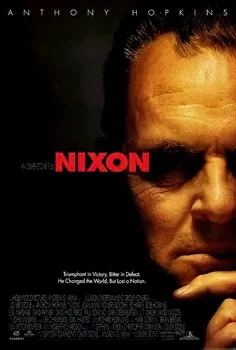Historical accuracy of Nixon

Historical accuracy of Nixon

Characters
Richard Nixon
Nixon is portrayed with historical accuracy regarding major life events, but the film heavily emphasizes psychological flaws (paranoia, insecurity, resentment) based on interpretation, making the overall characterization debated by historians.
Pat Nixon
Pat Nixon was known for her public composure. The film portrays this but adds layers of private awareness and suffering based on dramatic interpretation rather than fully documented accounts.
Hannah Nixon
Hannah Nixon was a strong influence. The film uses flashbacks to portray her impact, emphasizing piety and hardship accurately, but her direct influence on specific Nixon traits is interpretive.
Henry Kissinger
Kissinger's role, intellect, and accent are captured. However, the portrayal simplifies his complex relationship with Nixon and policy nuances for dramatic effect.
H.R. Haldeman
Haldeman's loyalty, appearance, and role as Nixon's gatekeeper ("Berlin Wall") align well with historical accounts.
John Ehrlichman
Ehrlichman's position and involvement in Nixon's inner circle and Watergate are historically accurate.
More characters
John Dean
Dean's role, initial involvement, and subsequent crucial testimony implicating Nixon in the Watergate cover-up are accurately depicted based on his known actions.
J. Edgar Hoover
Hoover's long tenure and power are shown. The film depicts him using secrets for influence, including against Nixon, which reflects common perceptions but specific interactions are dramatized.
Alexander Haig
Haig's role during the tumultuous final stages of Nixon's presidency is accurately portrayed.
John Mitchell
Mitchell's position and connection to decisions leading to Watergate (like approving Liddy's plans) are historically based.
Martha Mitchell
Martha Mitchell was known for her public statements hinting at scandals. The film accurately portrays her perceived instability and attempts by the administration to discredit her.
E. Howard Hunt
Hunt's role in organizing the break-in and his connection to the White House "Plumbers" unit are historically accurate.
G. Gordon Liddy
Liddy's eccentric personality and key role in planning the Watergate operation are consistent with historical accounts.
Story
Nixon's difficult Quaker upbringing
Nixon did have a modest Quaker upbringing marked by hardship (e.g., brothers' deaths). The film's emphasis on specific psychological impacts (resentment, drive) is interpretation.
Opening relations with China / Meeting Mao
Nixon's historic 1972 trip to China and meeting with Mao Zedong was a major foreign policy achievement and is accurately depicted as such.
Vietnam War policy (escalation, protests, negotiations)
The film accurately reflects Nixon's complex Vietnam policy: initial escalation ("secret bombing" of Cambodia implied), dealing with massive protests, and eventual efforts towards peace talks.
Kent State shootings mentioned
The shootings occurred during Nixon's presidency as a result of Vietnam War protests, representing the era's turmoil.
Creation of White House "Plumbers" unit
Nixon authorized the creation of this covert group to stop security leaks following the Pentagon Papers release; it later became involved in illegal activities like Watergate.
Watergate break-in and cover-up attempts
The break-in occurred, and the subsequent cover-up directed by Nixon's inner circle (hush money, perjury, political pressure) is the core historical basis of the scandal depicted.
The 18.5-minute gap in White House tapes
A crucial portion of a taped conversation was erased. The film depicts the mystery; the exact reason and person responsible remain officially unknown ("Nobody knows").
John Dean's testimony implicating Nixon
Dean's Senate testimony was a major turning point, directly linking Nixon to the cover-up.
Nixon's resignation
Facing certain impeachment over Watergate, Nixon resigned the presidency in August 1974.
Nixon's farewell speech to staff
Nixon gave an emotional, rambling farewell speech to his staff, excerpts of which are accurately recreated in the film.
Nixon talking to portraits in White House
Scenes showing Nixon talking aloud to presidential portraits (especially JFK) are dramatic devices used to explore his psyche, not documented events.
Speculation on "The Beast" (shadowy power brokers)
The film suggests a hidden cabal of industrialists influencing events (linked to Cuba, hints at JFK). This is a speculative conspiracy theory added by Stone, lacking credible historical evidence.
Nixon's heavy drinking / emotional instability
Accounts exist of Nixon drinking and showing emotional strain, especially under pressure. The film's depiction may exaggerate these aspects for dramatic effect.
Nixon's impromptu meeting with protesters at Lincoln Memorial
Nixon did make an unplanned pre-dawn visit to anti-war protesters at the Lincoln Memorial in May 1970, engaging in awkward conversation as depicted.
Hints connecting Nixon circle to JFK assassination plots
The film subtly links figures around Nixon (like Hunt, Cuban exiles) to JFK assassination theories, reflecting director Oliver Stone's viewpoint but lacking historical proof.
Setting
White House locations (Oval Office, etc.)
Key White House settings are meticulously recreated, providing an authentic backdrop for the political drama.
Nixon's childhood home / early California settings
Flashbacks effectively recreate the modest settings of Nixon's youth in Yorba Linda and Whittier, California.
China (Great Wall, meeting rooms)
The visual representation of Nixon's historic visit to China captures the settings associated with that event.
Costumes, hairstyles, vehicles (spanning decades)
The film accurately reflects the changing styles in clothing, hair, and cars from Nixon's youth through the early 1970s.
Technology (tape recorders, cameras, phones)
The portrayal of technology, particularly the reel-to-reel tape recording system central to Watergate, is accurate for the era.
Integration of archival news footage
The film skillfully blends real news footage (e.g., Vietnam War, protests, Watergate hearings) with dramatized scenes, enhancing authenticity.
Atmosphere of 1960s-70s political turmoil
Captures the intense political division, anti-war protests, Cold War tensions, and paranoia surrounding the Nixon administration and the Watergate scandal.
Washington D.C. political environment
The film conveys the high-stakes atmosphere of power, secrecy, and political maneuvering within the Washington establishment.
Recreation of specific rooms (e.g., Senate hearing room)
Key historical settings like the Senate Watergate Committee hearing room are visually recreated with attention to detail based on photos and footage from the time.
